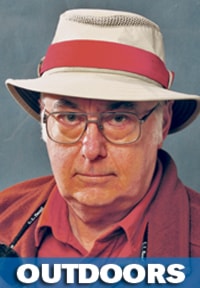Outdoors people have polite names for days like we’ve been having far too many of lately, too hot, too bright, too dry: “Bluebird Days” and “Cutthroat Days. Duck hunters hate Bluebird Days because the birds don’t fly then. But anglers love Cutthroat Days,” because our only significant native trout species, the west slope cutthroat (the threatened bull trout is a char and the also threatened Athabasca rainbow trout is rare and tiny) is alone among our trout in feeding heavily in hot, bright sunshine.
For that reason alone we should be far more protective than we are of our major threatened trout species. In the hot, bright “Dog Days” to come, both non-native rainbow, and particularly brown trout will become nocturnal, while the west slope cutthroat, a creature of the coldest water and air-conditioned high country, will feed happily in bright sunshine.
I learned much of that 65 years ago when I attended the official opening of the Highwood Pass section of what is now Hwy. 40, still, at 7200 feet, the highest piece of paved road in Canada. Even at 12 or 13 I never went anywhere without my fishing rig, in case of attack. Just below the road, under bright sunshine, was a series of beaver dams. Standing on one of them and casting a silver Gibbs “Tempter” spoon with my solid glass rod and Bronson Fleetwing level-wind, allegedly anti-backlash reel, I was suddenly attacked.
Something large and long rose from the dark depths, followed the wobbling spoon, and then ate it. After an epic battle during which I got soaked jumping in to throw my fish up on the dam, I had my first west slope cutthroat, 21 inches long, and my personal best for many years.
In the next several summers my dad and I fished the North Fork of the Belly River where one in ten of our catch of mostly 14-inch bull trout would be achingly beautiful football-shaped cutts occasionally hitting 16 inches.
Back in those innocent days we never dreamed we’d ever let big energy and forestry destroy headwaters spawning streams for our native cutthroat and bull trout. But we were officially worried about our pure west slope cutthroat disappearing owing to its tendency to mate with rainbow trout. To counter that threat, starting in 1955, we planted west slope eggs from Cranbrook in the North and South Ram Rivers where there were no fish above impassable falls, which would also keep the Ram cuts pure and safe from rainbow swains from below.
The purest strain west slope cutthroats left in Alberta today are probably those in the Ram system; the irony is they come from B.C. The tendency of some cutthroats to travel great distances gave me a surprise second 21-incher several years ago from Prairie Creek, a brown trout stream. This one had come over those Ram falls, down to the North Saskatchewan River and up the Clearwater River, then up Prairie Creek.
In all my high country cutthroat fishing, I can recall catching lots of cutts on only two days that that were not Cutthroat Days, but probably really were … with an asterisk. One bright, broiling September day we were fishing the South Ram below its junction with Hummingbird Creek when, without our notice, suddenly the equinoctial storm blew in.
The cutts increased their feeding frenzy, as though fattening up for a hard winter. We quit when icy hands could no longer wrangle worm onto hook, and got out of there just ahead of being snowed in.
A decade or so ago I took son John on a nostalgic trip to B.C.’s Bull River which his grandfather fished when he first came to Canada from London, England, as a teenager in the 1920s. It was hot and glaring and the many cutts we caught got larger the further upriver we fished.
Unfortunately, the smoke and heat from a forest fire the next range over got worse the closer we got to the headwaters. It was surreal: catching big cutts like mad in a darkness lit only by a ruby red sun. Those trout knew that, behind the pall of smoke, it really was a Cutthroat Day. Before we expired of smoke inhalation, or got pressed into firefighting, John and I retreated to fish the fine cutts of the Elk River and Michel Creek. We coughed wood smoke for weeks.
On a very hot, bright day on the North Ram River in late summer of 1999, I cast my fly, into the glare of the setting sun and lost sight of it. I tightened into a battle that tested the upper limits my cardiologist had set for the heart rate monitor he insisted I wear as a condition of letting me go on fishing and hunting.
That was the best-ever west slope cutthroat of my lifetime, 25 inches long, but I am reliably assured by Ram regulars that there are still larger being caught in both rivers … on Cutthroat Days.
Bob Scammell is an award-winning columnist who lives in Red Deer. He can be reached at bscam@telusplanet.net.
